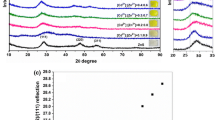Abstract
Cadmium tungstate (CdWO4) powders were synthesized by a hydrothermal method at different pH values. The samples show a pure monoclinic phase with the wolframite structure when they are synthesized at higher pH values. And the sample shows the highest crystallinity at a pH value of 7. All of the CdWO4 samples show the characteristic band at 788 cm−1 corresponding to symmetrical stretching vibration of W–O–W bond in WO4 2− group in Fourier transform infrared absorption spectra. The transmission electron microscope results show that the particle sizes increase with the increase of pH value, according with the results of X-ray diffraction. All synthesized CdWO4 samples show a broad blue–green emission at 350–550 nm. The emission intensity of sample synthesized at a pH value of 4 is nearly five times of that synthesized at a pH value of 1. These results indicate that the pH values have obvious influence on properties of CdWO4 crystal in the hydrothermal synthesis.




Similar content being viewed by others
References
S. Mann, G.A. Ozin, Nature 382, 313 (1996)
L. Manna, E.C. Scher, L.S. Li, A.P. Alivisatos, J Am Chem Soc 124, 7136 (2002)
Y. Yang, Mater Sci Eng B 178, 807 (2013)
A.P. Alivisatos, Science 271, 933 (1996)
C.M. Lieber, Solid State Commun 107, 607 (1998)
Y.G. Yang, Mater Res Innov 18, 267 (2012)
S. Vidya, S. Solomon, J.K. Thomas, J Mater Sci: Mater Electron 25, 693 (2014)
X.Y. Sun, X.G. Li, X.D. Sun, J. He, B.S. Wang, J Mater Sci: Mater Electron (2014). doi:10.1007/s10854-014-1778-5
X. Wang, B. Liu, Y. Yang, Opt Laser Technol 58, 84 (2014)
B. Gao, H. Fan, X. Zhang, L. Song, Mater Sci Eng B 177, 1126 (2012)
A.M. Piya, R.K. Selvan, B. Senthilkumar, M.K. Satheeshkumar, C. Sanjeeviraja, Ceram Int 37, 2485 (2011)
Y.B. Mao, S.S. Wong, J Am Chem Soc 126, 15245 (2004)
V.A. Pustovarov, A.L. Krymov, B.V. Shulgin, E.I. Zinin, Rev Sci Instrum 63, 3521 (1992)
C. Greskovich, D.A. Cusano, R.J. Riedner, D. Hoffman, Am Ceram Soc Bull 71, 1120 (1992)
K. Tanaka, N. Shirai, I. Sugiyama, R. Nakata, Nucl Instrum Methods Phys Res B 121, 404 (1997)
C.L. Melcher, R.A. Manente, J.S. Schweitzer, IEEE Trans Nucl Sci 36, 1188 (1989)
Y. Wang, J. Ma, J. Tao, X. Zhu, J. Zhou, Z. Zhao, L. Xie, H. Tian, Ceram Int 33, 1125 (2007)
A.M. Priya, R.K. Selvan, B. Senthilkumar, M.K. Satheeshkumar, C. Sanjeeviraja, Ceram Int 37, 2485 (2011)
Y. Ling, L. Zhou, L. Tan, Y. Wang, C. Yu, CrystEngComm 12, 3019 (2010)
W. Tong, L. Li, W. Hu, T. Yan, G. Li, J Phys Chem C 114, 1512 (2010)
H.-L. Wang, X.-D. Ma, X.-F. Qian, J. Yin, Z.-K. Zhu, J Solid State Chem 177, 4588 (2004)
D.S. Sofronov, E.M. Sofronova, V.V. Starikov, V.N. Baymer, K.A. Kudin, P.V. Matejchenko, A.G. Mamalis, S.N. Lavrynenko, Mater Manuf Process 27, 490 (2012)
M. Hojamberdiev, R. Kanakala, O. Ruzimuradov, Y. Yan, G. Zhu, Y. Xu, Opt Mater 34, 1954 (2012)
Y. Liu, R. Zuo, J Mater Sci: Mater Electron 23, 2276 (2012)
C. Cao, A. Xia, S. Liu, L. Tong, J Mater Sci: Mater Electron 24, 4901 (2013)
Y. Wang, J. Ma, J. Tao, X. Zhu, J. Zhou, Z. Zhao, L. Xie, H. Tian, Mater Sci Eng B 130, 277 (2006)
G. Huang, Y. Zhu, Mater Sci Eng B 139, 201 (2007)
L. Jin, Y. Qu, B. Wang, S. Li, B. Jiang, L. Yang, W. Fu, H. Fu, J. Sun, Sol Energ Mat Sol C 90, 1773 (2006)
Acknowledgments
This work is supported by NSFC (Grant No. 51221291), Tsinghua University Initiative Scientific Research Program, and Beijing Key Lab of Fine Ceramics.
Author information
Authors and Affiliations
Corresponding author
Rights and permissions
About this article
Cite this article
Chu, XC., Xu, YN. & Li, LT. Hydrothermal synthesis and effects of pH values on properties of CdWO4 powders. J Mater Sci: Mater Electron 25, 2601–2604 (2014). https://doi.org/10.1007/s10854-014-1917-z
Received:
Accepted:
Published:
Issue Date:
DOI: https://doi.org/10.1007/s10854-014-1917-z




